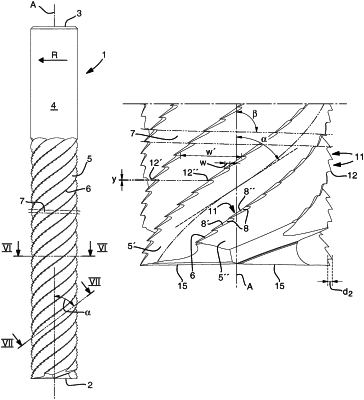| CPC B23C 5/10 (2013.01) [B23C 2210/0485 (2013.01); B23C 2210/088 (2013.01); B23C 2210/326 (2013.01)] | 15 Claims |

|
1. A rotatable cutting tool for machining of a workpiece having a honeycomb core, the cutting tool having a longitudinal axis around which the cutting tool is rotatable in a direction of rotation, the cutting tool comprising:
a front end;
a rear end opposite the front end, the cutting tool being arranged to be fastened to a tool holder or a machine spindle;
a peripheral surface extending around the longitudinal axis between the front end and the rear end;
a set of helical flutes arranged for chip evacuation formed in the peripheral surface, the helical flutes extending from the front end towards the rear end at a first helix angle α with respect to the longitudinal axis, wherein 45°≤α≤65°, the helical flutes having a first depth;
a set of helical ridges, each helical ridge being associated with and formed between a pair of adjacent helical flutes comprising a first associated helical flute and a second associated helical flute, wherein the second associated helical flute is positioned behind the first associated helical flute in the direction of rotation; and
at least one helical groove formed in the peripheral surface, the at least one helical groove having a second depth which is smaller than the first depth, so that the at least one helical groove is interrupted by the helical flutes, wherein the at least one helical groove intersects the helical ridges so that a plurality of lands are formed on each helical ridge, each land extending between the first associated helical flute and the second associated helical flute, and wherein a plurality of cutting teeth are formed on each helical ridge, each cutting tooth being delimited at least by a pair of associated adjacent lands of said plurality of lands, said pair of associated adjacent lands comprising a first associated land and a second associated land, wherein the second associated land is positioned at a larger axial distance from the front end than the first associated land, wherein the at least one helical groove extends at a second helix angle β with respect to the longitudinal axis, wherein 90°<β<100°, and wherein each cutting tooth of said plurality of cutting teeth comprises:
a second ridge, the second ridge being formed in a transition between the first associated land and the second associated land,
a cutting edge formed in a transition between the first associated land and the first associated helical flute, and
a clearance edge formed in a transition between the second associated land and the first associated helical flute, wherein the second ridge, the cutting edge and the clearance edge join in a tooth tip constituting the radially outermost point of the cutting tooth and being located at a cutting radius of the cutting tool.
|